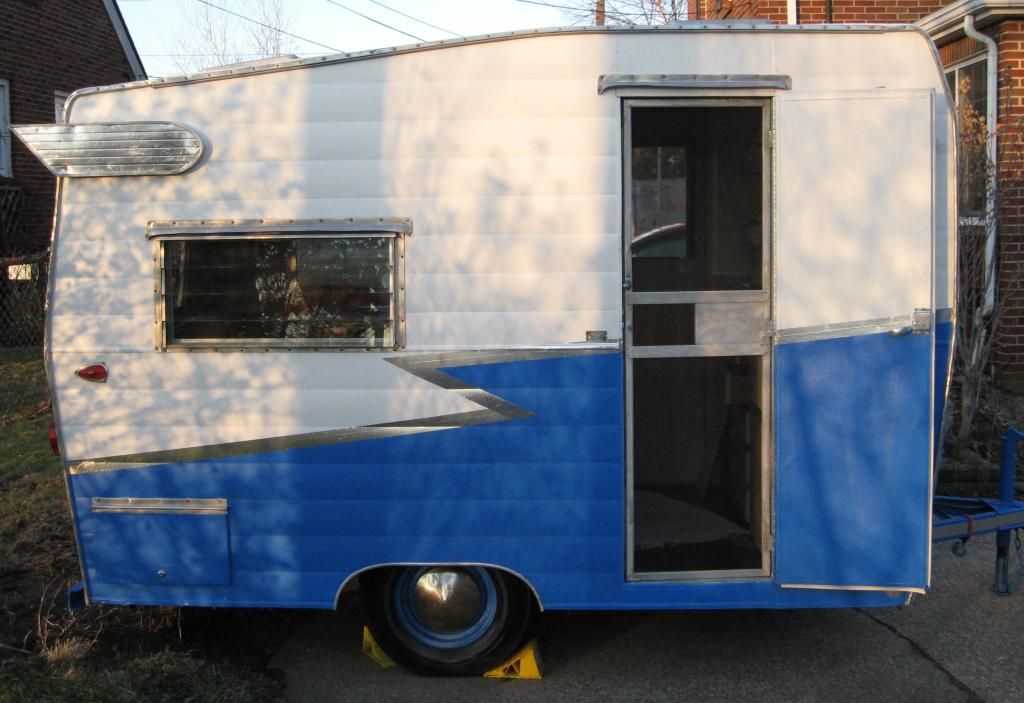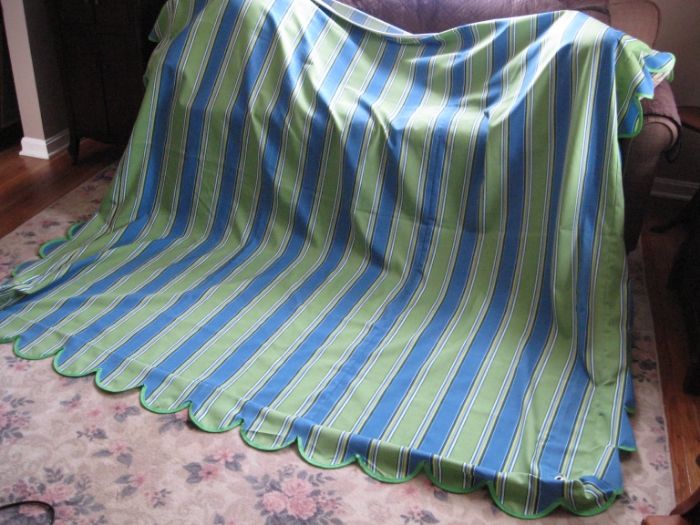Awning DIY by Redwings
Jun 20, 2013 10:57:22 GMT -8
coloradoan, mountainsounds, and 1 more like this
Post by redwings on Jun 20, 2013 10:57:22 GMT -8
I've
had a few inquiries into how I sewed my own awning for my Compact. I
made mine for under $50 (Hey! The $50 Awning Job!) and have written down
a tutorial. It helps if you can get the awning fabric on sale. I didn't
buy the Sunbrella fabric but rather used a nice awning canvas purchased
at JoAnn fabric. They frequently have 50% off coupons which makes a
good savings when the fabric is $15-$20/yard and you need 7 plus yards
of it). Another good source for outdoor fabric is www.fabricguru.com. Also, make sure you use a high quality and sturdy thread for the
job. I sewed this just using my cheap $150 Singer so you don't need a
heavy duty machine.
Measure the width of your awning rail.
I made my awning two inches shorter than the awning rail so I could
whittle down wine corks to plug up the ends to keep the awning in the
rail during high wind weather.
Determine how far out in front
of your trailer you want your awning to go. I chose 7 feet and have
been quite happy with that but I have seen much longer ones for sale. I
think it depends on the size of your trailer and how much shade you
want. The 7 feet works perfect for my little Shasta compact.
Cut
your fabric to the measurements you’ve decided, making sure to
leave seam width allowances. Since my fabric wasn’t wide enough to make
the width I had to use two lengths of 7 feet each and sew them together
in the middle. Example: My awning rail was 84 inches wide. My fabric was
only 50" wide. I cut two 7 foot long pieces at 42 inches wide each and
sewed them together with a middle seam using 1/2" seam allowance.
Sew
the middle seam using a french seam (where you sew it once wrong
sides together 1/4”, then encase the seam by sewing another seam, but
right sides together 1/2). Here’s a website that gives good directions
for this:
www.sewneau.com/how.to/french.seam.html

Cut
the scalloped skirt (this addition is optional but it sure makes
the awning look vintage and cute!). I cut mine 7 1/2” x the length of
the awning (7 feet). Fabricate two of these--one for each side. Then cut
one more to go along the front of the awning..whatever width you have
chosen. You may have to join pieces like mentioned above (french seam)
to make the width and lengths needed. I made sure that my stripes were
vertical on all 3 sides as this was the way vintage ones were made. For
the scallop edges I found a plate with a diameter of 7 1/2 inches and
traced the half-round scallops along the bottom edge of the skirt. I’m
kind of a perfectionist so I fussed around with the plate until I was
sure I would have a complete scallop at each corner edge (where the
sides meet the front).

Bind
the scallop skirt: Using white seam binding tape (double fold bias
tape 1/2”) and using a zig zag stitch stitch the binding tape to the
scalloped edge of the skirt starting at the upper back edge (the edge
that will be next to the trailer) . Do not apply the binding tape to the
front corner sides of the skirt. These are the edges of the skirt that
will meet up in the front to form the side and front corners. So, for
the front skirt you won’t sew the binding up the outside edges of the
skirt but will start at the beginning of the curved scalloped. You will
stitch the seam binding on the corners after you sew the corner seams
together. This I had to fuss around a bit to figure out how to do it,
and I came up with this. I’m sure if you figure out a better way it
would work too!

Stitch
the front skirt onto the front of the awning with wrong sides
together and using 1/4” seam allowance. Next encase this seam with seam
binding tape and sew it using a large zig zag stitch. This gives you a
double seam and I think adds more strength to the awning.
Stitch
each side of the skirt to the sides of the awning in same manner as
front (1/4” seam). Stitch the two corner seams together using 1/4” seam
allowance). Now sew on the seam binding tape using a large zig zag
stitch starting at the back (trailer end) of the seam and wrapping the
tape around the front corner seam ending at the front lower edge of the
corner of the awning. Again, if you fuss around and find a better way to
do this...all the better!
Now comes the hard part--sewing a
cable or rubber tube into a length of folded over awning material,
and then stitching it to the back of the awning (the trailer side). I
measured the diameter of my awning rail opening (it was 1/2”) and went
to my local hardware/feed store (Big R) and bought rubber-wrapped
twisted airplane cable the exact length I needed to feed into the awning
rail (2 inches shorter than the awning rail). This stuff is a bugger to
cut so it’s best to have them cut it to the exact length you need. I
think I bought 3/8” and knew that when I wrapped my material around it
it would fit snugly into the awning rail opening which is 1/2". You
don’t want it too snug as you will be struggling to get the dang awning
threaded in. You also don’t want it too loose as then you will be
constantly fighting it to stay in (unless you do the wine cork trick I
mentioned above! One for each side. Guess that means you have to drink
two bottles of wine...shucks!)
Place
the cable or tube on a length of awning fabric two inches longer
than the cable or tube and three inches wider than the cable or tube.
Fold over the top edge of the fabric to meet the bottom edge. Using a
zipper foot sew the cable or tube snugly into the fabric, not unlike
sewing a cord to make fancy upholstery binding. At the ends of the
cable/tube fold over each end of the fabric twice to completely enclose
the ends and stitch these down. This will keep the cable or tube
securely in place and it is now completely encased!

To
make a finished edge on this tube thing (long edge) fold under
the awning fabric 1/2” once and stitch this under. This still leaves
about an inch with which to sew the cable/tube contraption to the back
of the awning. When you sew this onto the back of the awning make sure
it sticks out far enough like a flap that you can slide it into the
awning rail.

Another BETTER option is to buy Keder Awning Rope from Sailrite. Then you just sew this rope onto the edge of your awning and it slides into your awning rail.
Lastly,
set in place two grommets as close to the front corner edges as
possible. Make sure these grommet holes are large enough to accommodate
the awning poles you have chosen, but not too large that the poles swim
in them. (I sewed in two squares to reinforce each corner edge before I
placed the grommets.) I purchased the grommets and tools at my local
fabric store and they were pretty inexpensive and easy to affix.


I
went to Wal Mart and bought the telescoping Coleman tent poles,
but I’ve read on the forum that these aren’t as strong as others
available. I couldn’t beat the price ($10 each) and since my trailer and
awning is fairly small they work ok. But I can see the advantage to
having stronger poles--especially in windy times! I once had to get up
at 1 am to rescue my awning which had loosed itself and was hanging half
off the rail. (Needed stronger corks)
Hope this helps and isn't
too confusing. I'm not stellar at giving directions or instructions so
with luck I haven't forgotten a step! I am willing to answer any
questions anyone may have. Just e-mail me.
I also am available to hire for sewing your awning. Just email me: diane75rae@gmail.com
Diane












